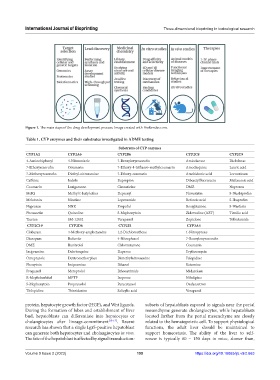Page 207 - IJB-9-2
P. 207
International Journal of Bioprinting Three-dimensional bioprinting in toxicological research
Figure 1. The main steps of the drug development process. Image created with BioRender.com.
Table 1. CYP enzymes and their substrates investigated in ADME testing
Substrates of CYP enzymes
CYP1A2 CYP2A6 CYP2B6 CYP2C8 CYP2C9
4-Aminobiphenyl 4-Nitroanisole 7-Benzyloxyresorufin Amiodarone Diclofenac
7-Ethoxyresorufin Coumarin 7-Ethoxy-4-trifluoro-methylcoumarin Amodiaquine Lauric acid
7-Methoxyresorufin Diethyl-nitrosamine 7-Ethoxy-coumarin Arachidonic acid Lornoxicam
Caffeine Indole Bupropion Dibenzylfluorescein Mefenamic acid
Coumarin Losigamone Cinnarizine DMZ Naproxen
MeIQ Methyl t-butyl ether Deprenyl Fluvastatin S-Flurbiprofen
Melatonin Nicotine Loperamide Retinoic acid S-Ibuprofen
Naproxen NNK Propofol Rosiglitazone S-Warfarin
Phenacetin Quinoline S-Mephenytoin Zidovudine (AZT) Tienilic acid
Tacrine SM-12052 Verapamil Zopiclone Tolbutamide
CYP2C19 CYP2D6 CYP2E1 CYP3A4
Clobazam 4-Methoxy-amphetamine 1,2-Dichloroethene 1-Nitropyrene
Diazepam Bufurolo 4-Nitrophenol 7-Benzyloxyresorufin
DMZ Bunitrolol Chlorzoxazone Coumarin
Imipramine Debrisoquine Dapsone Erythromycin
Omeprazole Dextromethorphan Dimethylnitrosamine Felopidine
Phenytoin Imipramine Ethanol Ketamine
Proguanil Metoprolol Ethosuximide Midazolam
R-Mephobarbital MPTP Isoprene Nifedipine
S-Mephenytoin Propranolol Paracetamol Ondansetron
Ticlopidine Thioridazine Salicylic acid Verapamil
protein, hepatocyte growth factor (HGF), and Wnt ligands. subsets of hepatoblasts exposed to signals near the portal
During the formation of lobes and establishment of liver mesenchyme generate cholangiocytes, while hepatoblasts
bud, hepatoblasts can differentiate into hepatocytes or located farther from the portal mesenchyme are closely
cholangiocytes after lineage-commitment [15-17] . Recent related to the hematopoietic cell. To support physiological
research has shown that a single Lgr5-positive hepatoblast functions, the adult liver should be maintained to
can generate both hepatocytes and cholangiocytes in vivo. support homeostasis. The ability of the liver to self-
The fate of the hepatoblast is affected by signal transduction: renew is typically 60 – 150 days in mice, slower than,
Volume 9 Issue 2 (2023) 199 https://doi.org/10.18063/ijb.v9i2.663

